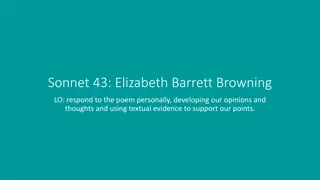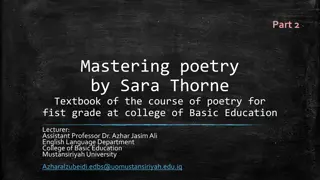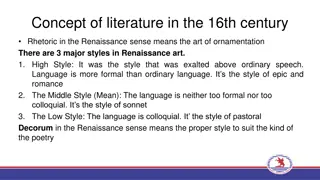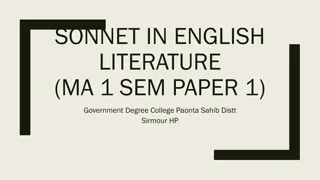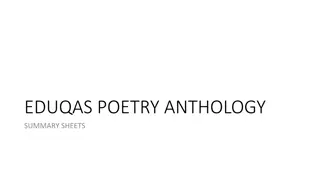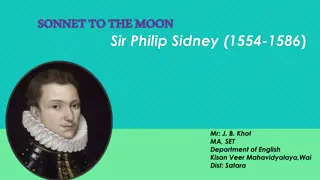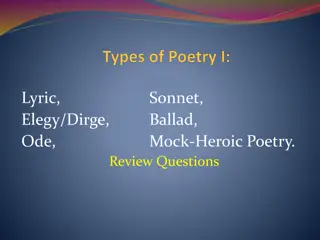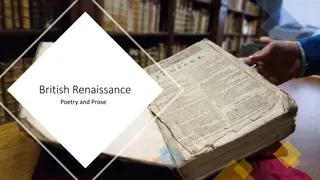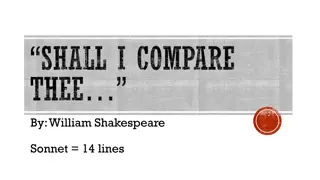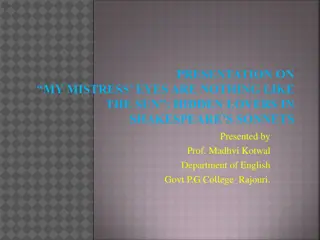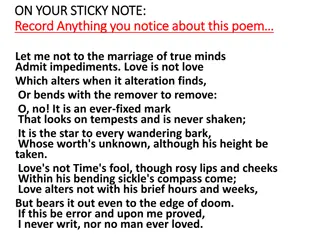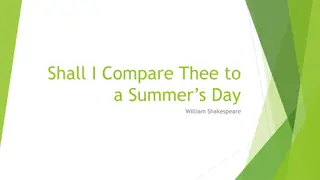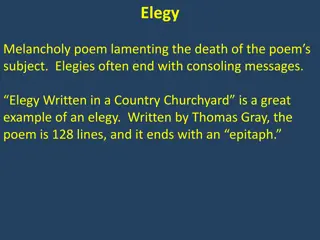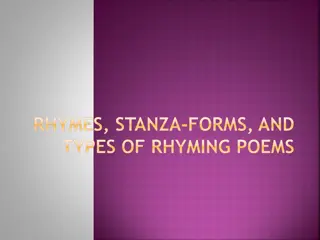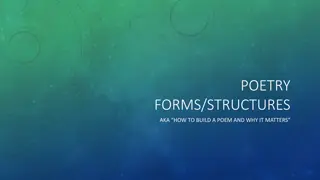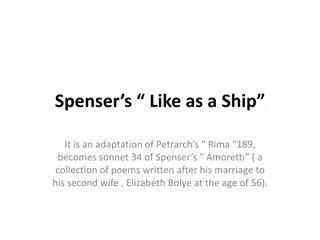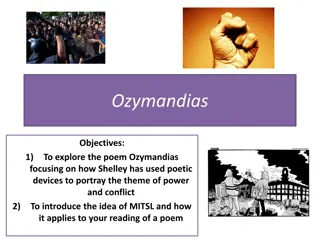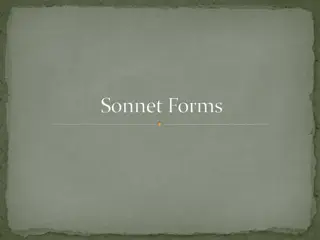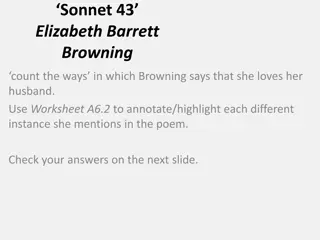Analysis of Sonnet 65 by William Shakespeare
Sonnet 65 by William Shakespeare explores the theme of Time as a powerful force that defies all earthly materials. The poet contemplates how beauty, no matter how strong, will ultimately succumb to Time's relentless passage. The sonnet delves into the idea of immortality through poetry, suggesting t
0 views • 6 slides
Analysis of Love and Devotion in Sonnet 43 by Elizabeth Barrett Browning
Sonnet 43 by Elizabeth Barrett Browning portrays intense love and unwavering devotion as the speaker expresses a deep connection with her lover, describing their love as spiritual and boundless. Through analysis of language, structure, and form, the poem reveals the speaker's profound emotions, the
2 views • 17 slides
Exploring the Art of Sonnets in Poetry
Delve into the world of sonnets with a focus on Petrarchan and English sonnet forms. Understand the structure, rhyme schemes, and themes these poetic forms offer through examples like Shakespeare's Sonnet 116. Discover the timeless appeal and influence of sonnets in Western literature.
2 views • 12 slides
Analysis of Shakespeare's Sonnet 60: Time and Mortality
Shakespeare's Sonnet 60 delves into the universal themes of time and mortality through vivid imagery and poignant reflections. The poem uses concrete images like waves and minutes to symbolize time's relentless progression and its impact on human life. As the sonnet progresses, the poet contemplates
2 views • 14 slides
Literature in the 16th Century: Styles, Patronage, and Poetry Traditions
Explore the concept of literature in the 16th century, focusing on rhetoric in the Renaissance, major styles in art, the role of courtiers and patrons, poetic traditions like heroic, Ovidian, pastoral, and sonnet, and delve into the analysis of Sir Thomas Wyatt the Elder's poem "The Long Love that i
0 views • 4 slides
The Art of Sonnets in English Literature
A sonnet is a 14-line lyric poem written in iambic pentameter with a specific rhyme scheme and thought structure. There are three main types of sonnets - Italian/Petrarchan, Spenserian, and English/Shakespearian. Each type has a unique rhyme scheme and style. Notable poets like Shakespeare, Spencer,
0 views • 13 slides
Eduqas Poetry Anthology: Themes and Poems Summary
Explore the diverse themes and poems within the Eduqas Poetry Anthology, including "The Manhunt," "Sonnet 43," "London," "The Soldier," "She Walks in Beauty," "Living Space," "As Imperceptibly as Grief," "Cosy Apologia," "Valentine," "A Wife in London," "Death of a Naturalist," "Hawk Roosting," "To
0 views • 20 slides
Shakespeare's Sonnet 60 Analysis and Insights
Shakespeare's Sonnet 60 is a poignant reflection on the passage of time and mortality. The poem vividly captures the relentless march of time, likening it to the waves steadily approaching the shore. Through concrete imagery and powerful metaphors, the sonnet explores the fleeting nature of youth, b
0 views • 12 slides
Sonnet to the Moon by Sir Philip Sidney: A Poetic Ode to Unrequited Love
Born in 1554, Sir Philip Sidney was an Elizabethan courtier, poet, and scholar. "Sonnet to the Moon" from his work "Astrophel and Stella" explores unrequited love through an address to the moon as a sympathetic observer. The poem reflects on the nature of love, beauty, and virtue. With eloquent imag
0 views • 9 slides
Analysis of John Milton's Poem "How Soon Hath Time
In "How Soon Hath Time," John Milton reflects on the passage of time and its impact on his own life. He laments how quickly time steals away youth and reveals his introspective thoughts on reaching manhood. The poem explores themes of aging, self-reflection, and the inevitability of time's passage i
0 views • 11 slides
Analyzing "The Next War" by Wilfred Owen: A Sonnet of Death and Hope
Wilfred Owen's poem "The Next War" explores shifting perspectives on death and war among soldiers in the trenches, using a unique sonnet structure blending Italian and English forms. Through inclusive language and personification of Death, Owen highlights themes of camaraderie, courage, and the acce
0 views • 9 slides
Sir Thomas Wyatt and the Poem "Whoso List to Hunt
Sir Thomas Wyatt, a prominent figure in English poetry, is credited with popularizing the Petrarchan Sonnet in England. His poem "Whoso List to Hunt" reflects his feelings for Anne Boleyn, portrayed as a deer, and Henry VIII as "Caesar." Wyatt expresses his weariness in pursuing the elusive quarry,
0 views • 12 slides
Understanding Different Forms of Poetry
Explore the characteristics of different types of poetry such as lyric, elegy/dirge, ode, sonnet, ballad, and mock-heroic poetry. Delve into the personal feelings expressed in lyric poems and the structured beauty of sonnets. Discover the emotive power of elegies and the celebratory nature of odes.
2 views • 15 slides
British Renaissance Poetry and Prose: Influential Poets and Their Works
Explore the world of British Renaissance poetry and prose through the works of renowned poets like Sir Thomas Wyatt, Edmund Spenser, and Sir Philip Sidney. Dive into the evolution of the sonnet form, from Wyatt's introduction of the Italian/Petrarchan sonnet to Spenser's masterpieces like "The Faeri
1 views • 13 slides
Analysis of Shakespeare's Sonnet: Shall I Compare Thee
Shakespeare's Sonnet "Shall I Compare Thee" explores the speaker's admiration for his beloved, claiming she surpasses the beauty of a summer day. The poem delves into themes of eternal love, beauty, and the inevitable fading of physical allure. Through vivid imagery and poetic devices, Shakespeare c
0 views • 12 slides
Unveiling Hidden Themes in Shakespeare's Sonnets: An Analysis of "My Mistress' Eyes Are Nothing Like the Sun
Delve into the concealed themes of pagan religion, solar energy, and fossil fuels in Shakespeare's Sonnets through an intricate analysis of selected poems. Explore the allegorical use of sun worship and the underlying message of procreation intertwined with religious motifs in Sonnet 7.
0 views • 10 slides
Analysis of "Glasgow Sonnet i" with Annotated Themes and Literary Devices
Glasgow Sonnet i" explores themes of decay, neglect, poverty, and social injustice in a tenement setting. The poem describes the external and internal aspects of the building, portraying a bleak picture of marginalized individuals living within it. Through vivid imagery and literary devices like per
0 views • 7 slides
Exploring Shakespearean Sonnets: Understanding Love and Iambic Pentameter
Delve into the beauty and complexity of Shakespeare’s sonnets, focusing on the timeless theme of love and the rhythmic structure of iambic pentameter. Discover the essence of true love described as unwavering and constant amidst life’s challenges, and unravel the significance of iambic pentamete
0 views • 27 slides
Analysis of Shakespeare's Sonnet "Shall I Compare Thee to a Summer's Day
Shakespeare's Sonnet 18, "Shall I Compare Thee to a Summer's Day," explores the speaker's decision not to compare their beloved to a summer day due to the impermanence of summer's beauty. Instead, the sonnet praises the eternal beauty of the beloved, highlighting the depth of emotion and admiration
0 views • 15 slides
Understanding and Enjoying Poetry: Unraveling the Sonnet Form through Petrarch
Delve into the intricacies of interpreting poetry, specifically the sonnet form, focusing on the origins of the Italian sonnet and the influence of poets like Petrarch. Explore the complexities of Petrarch's sonnets in relation to love, inner conflict, and unfulfilled desires, shedding light on the
1 views • 39 slides
Explore Poetry: An Overview of Different Poetic Forms and Examples
Delve into the world of poetry with an exploration of various forms like elegy, epitaph, ode, hymn, sonnet, and ballad. Discover examples from renowned poets such as Thomas Gray, Robert Herrick, Robert Creeley, Julia Ward Howe, Claude McKay, and Edgar Allan Poe. Each form showcases a unique style an
0 views • 14 slides
Understanding Rhymes, Stanza Forms, and Types of Rhyming Poems
Explore the world of rhymes through couplets, tercets, quatrains, sixains, and sonnets. Learn about different stanza forms and types of rhyming poems like Italian sonnets and the structure of a sonnet. Unveil the beauty and complexity of poetic composition in various rhyming schemes.
0 views • 14 slides
Sir Thomas Wyatt and His Poem "Whoso List to Hunt
Sir Thomas Wyatt, a prominent figure in English literature, is credited with popularizing the Petrarchan Sonnet in England. His poem "Whoso List to Hunt" reflects his feelings towards Anne Boleyn, depicting her as a deer and Henry VIII as "Caesar." Through intricate imagery, Wyatt conveys personal d
0 views • 12 slides
Analysis of Sonnet 18 by William Shakespeare
The famous Sonnet 18 by William Shakespeare praises the eternal beauty of the beloved. The poet compares the beloved to a summer day but highlights the beloved's superiority due to their enduring beauty. The sonnet explores themes of timelessness, love, and the power of poetry to immortalize beauty.
0 views • 8 slides
Understanding Meter, Rhyme, and Verse in Poetry
Explore the fundamentals of meter, rhyming couplets, and iambic pentameter in poetry. Delve into the structure of different poetic forms and learn how to scan lines to identify poetic feet and syllables. Discover the timeless elegance of Shakespeare's Sonnet 116 as an example of poetic excellence.
1 views • 11 slides
Understanding Poetry Forms and Structures: How to Craft Poems Successfully
Delve into the essence of poetry creation by learning about the building blocks - from lines, couplets, and stanzas to fixed and free forms. Discover the significance of rhyme schemes, and explore essential vocabulary like caesura, enjambment, and end-stopped lines. Uncover the beauty of traditional
0 views • 10 slides
Silent Expressions of Love: Analysis of "When all the others were away at Mass" by Seamus Heaney
When all the others were away at Mass" by Seamus Heaney explores the silent yet profound bond between a mother and son, highlighting how ordinary moments hold deep meaning. The poem, structured as a sonnet, transitions from a childhood memory to the moment of the mother's death, emphasizing the impo
0 views • 4 slides
Life and Contributions of Henry Howard, Earl of Surrey
Henry Howard, Earl of Surrey, a prominent figure in English literature, was born in 1517 and executed in 1547 for his loyalty to the Roman Catholic Church. He followed the Italian forms adapted by Wyatt, translating Petrarch's sonnets. Surrey's work contributed to the development of the English sonn
0 views • 10 slides
Analysis of Spenser's Sonnet 34: "Like as a Ship" from Amoretti
Spenser's Sonnet 34 from Amoretti depicts a ship lost at sea as an analogy for the poet's estrangement from his wife, Elizabeth. Through vivid imagery and alliteration, Spenser conveys the despair of being adrift without his guiding light. The poem reflects themes of longing, forgiveness, and hope f
0 views • 7 slides
Exploration of Power and Conflict in Shelley's "Ozymandias
Delve into Percy Bysshe Shelley's sonnet "Ozymandias" to uncover how poetic devices are wielded to depict themes of power and conflict. Unpack the concept of MITSL and its relevance to interpreting poetry. Reflect on the grandeur of the ancient city and the fallen ruler represented by the broken sta
0 views • 15 slides
Insights into Sonnet Forms and Origins
Explore the origins and intricacies of sonnet forms through the Petrarchan Sonnet by Francesco Petrarch and the Shakespearean Sonnet by William Shakespeare. Learn about the structure, rhyme schemes, and emotional depth of these poetic forms through exquisite examples and analysis.
0 views • 13 slides
Analyzing Sonnet 43 by Elizabeth Barrett Browning
Explore the depth of love expressed in Sonnet 43 by Elizabeth Barrett Browning through an annotation and analysis of each instance she mentions how she loves her husband. Discover the intense emotions and emotive language presented in the poem, highlighting the cadences of expression and the freedom
0 views • 4 slides

